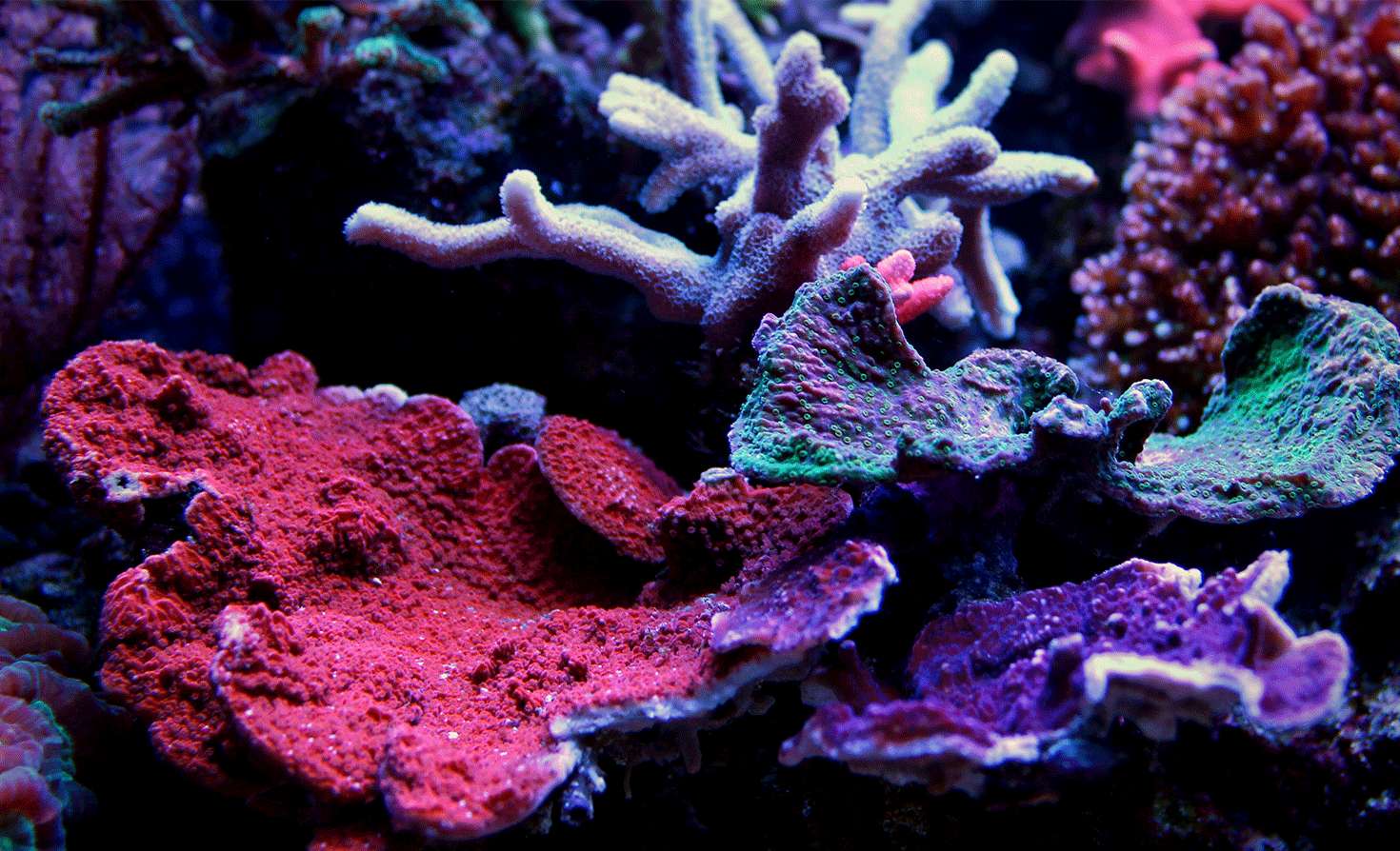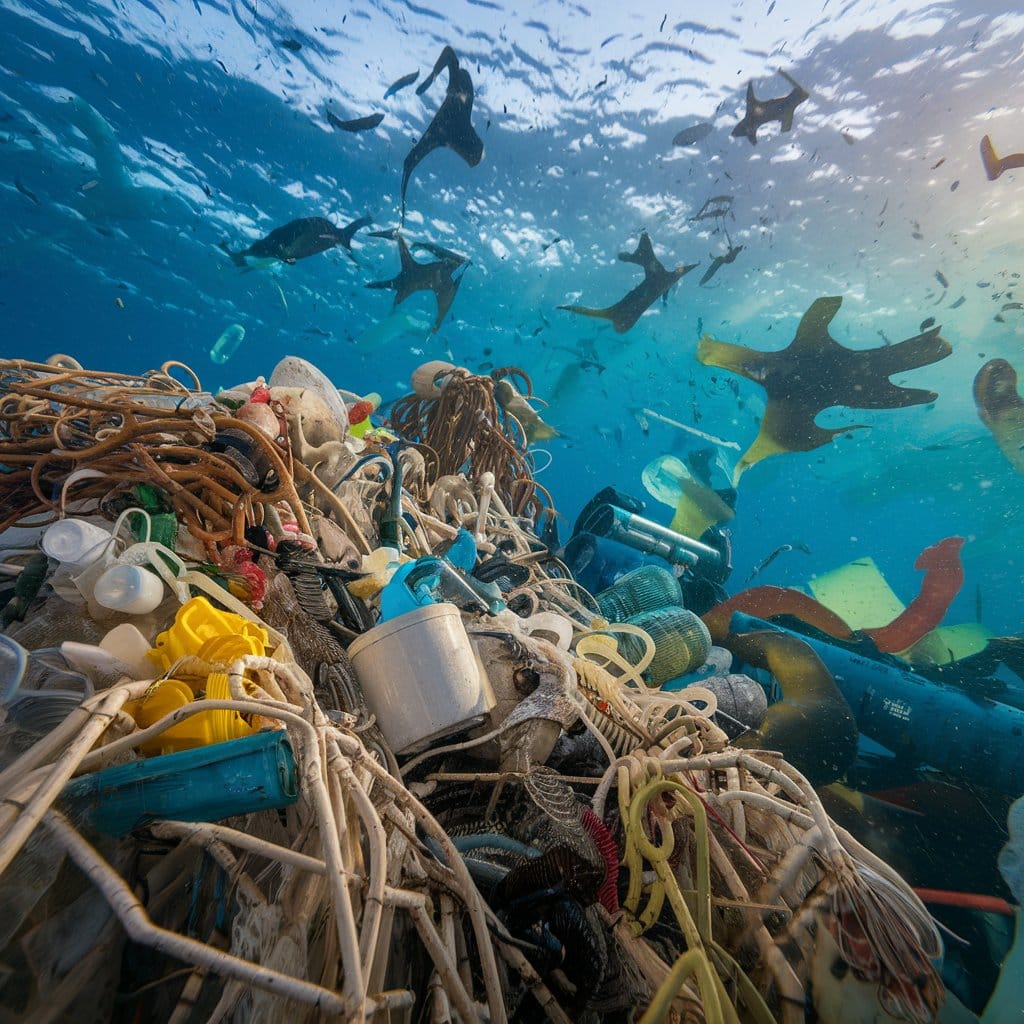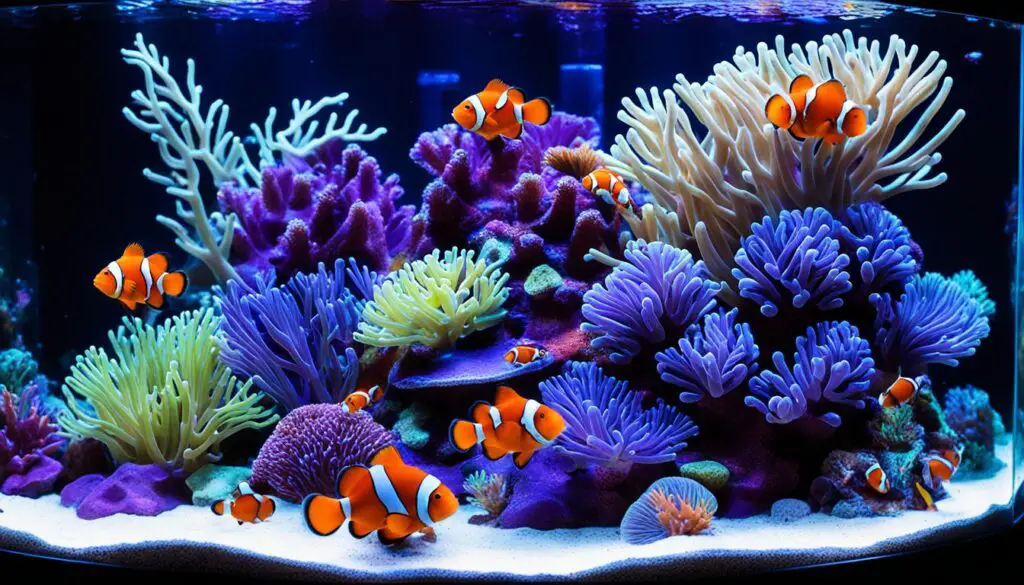How Does Coral Get Its Color

Introduction
How Does Coral Get Its Color: Coral reefs are not only mesmerizing underwater ecosystems but also vibrant kaleidoscopes of color. The striking hues and patterns that adorn these marine wonders are a product of a delicate and intricate partnership between the corals themselves and microscopic algae known as zooxanthellae.
Corals, often mistakenly perceived as lifeless rocks, are actually colonies of tiny organisms called polyps. These polyps secrete calcium carbonate skeletons that provide the structural framework for the reef. However, what truly captivates the eye is the astonishing array of colors that corals exhibit. But how do they acquire these captivating pigments?
The secret behind coral’s vivid colors lies in a mutualistic relationship with zooxanthellae. These single-celled algae take up residence within the coral polyps’ tissues, forming a symbiotic bond. In exchange for shelter and access to essential nutrients, the zooxanthellae photosynthesize, converting sunlight into energy and producing pigments as a byproduct.
The pigments produced by zooxanthellae, primarily chlorophylls, and carotenoids, give corals their brilliant colors. Chlorophylls are responsible for the vibrant greens and blues seen in some coral species, while carotenoids produce the warm reds, oranges, and yellows found in others. The precise combination of pigments and the intensity of their expression can vary between coral species, resulting in the astonishing diversity of colors found in coral reefs worldwide.

What makes coral Colour?
Coral Polyps
Millions of zooxanthellae live inside the tissues of these polyps. These zooxanthellae produce pigment, and because they reside in the clear tissue of the polyp, the pigments are visible, and the corals get their beautiful colors.
The vibrant and captivating colors of coral are a product of a remarkable partnership between the coral organisms themselves and tiny, photosynthetic algae known as zooxanthellae. Coral reefs, often referred to as the “rainforests of the sea,” are renowned for their stunning array of colors, but the true magic happens within the tissues of the coral polyps.
Corals are colonial organisms composed of numerous polyps that form calcium carbonate skeletons. However, it’s the presence of zooxanthellae that truly brings the colors to life. These microscopic algae inhabit the coral polyps’ tissues, establishing a mutually beneficial relationship. In exchange for a safe haven within the coral’s protective structure and access to vital nutrients, the zooxanthellae engage in photosynthesis.
Photosynthesis is the key to the coral’s vibrant colors. Within the symbiotic relationship, the zooxanthellae harness sunlight to produce energy. During this process, they synthesize pigments, primarily chlorophylls and carotenoids, as byproducts. These pigments are responsible for the rich and diverse palette of colors displayed by corals.
Chlorophylls are responsible for the greens and blues seen in some coral species, while carotenoids produce the reds, oranges, and yellows found in others. The specific combination and concentration of these pigments can vary between coral species, contributing to the astonishing diversity of colors found in coral reefs worldwide.
However, this partnership extends beyond aesthetics. Coral coloration serves as a vital indicator of their health. When stressed due to factors like rising sea temperatures or pollution, corals can expel their zooxanthellae in a process known as coral bleaching.
When did coral become a color?
1513
The first recorded use of coral as a color name in English was in 1513.
The term “coral” as a color designation likely emerged during the late 19th century, although the exact origin remains somewhat obscure. The color itself is reminiscent of the warm, pinkish-orange tones found in certain species of coral, particularly the precious coral known for its use in jewelry.
Historically, “coral” as a color was associated with the natural hue of coral reef formations and the beautiful underwater ecosystems they represent. It became popular in fashion and design during the Victorian era, a period characterized by a fascination with the natural world and the use of natural motifs in art and fashion. The soft, warm, and delicate shade of coral was highly sought after and often used in textiles, jewelry, and interior decor.
Over time, the popularity of the coral color has endured and evolved. It has been adapted into various shades and tones, ranging from pale peach to deeper salmon, to suit different aesthetic preferences and trends. Today, coral remains a versatile and appealing color choice in fashion, home decor, and design, often evoking feelings of warmth, femininity, and tropical beauty.
The enduring popularity of coral as a color is a testament to the timeless allure of nature’s hues and their ability to inspire human creativity and expression.
What color is coral based on?
Coral’s Color Family
Most modern viewers would consider coral to be a shade of orange-pink, placing it within the orange color family, and certainly within the gentler warm side of the spectrum. Coral sits within the orange or red color families, depending on whether it contains more red, pink, or orange.
Coral, as a color, is primarily based on the warm and pinkish-orange hues reminiscent of actual coral reef formations. The name “coral” for this color is directly inspired by the appearance of certain species of coral found in marine environments. These living organisms can exhibit a spectrum of colors, with shades ranging from pale pinks and soft oranges to deeper reds and even hints of brown.
The choice of “coral” as a color name is rooted in the fascination humans have had with coral reefs for centuries. The natural beauty of these underwater ecosystems, with their vibrant and diverse marine life, has long captivated people’s imaginations. The delicate, warm, and inviting tones of coral evoke the peaceful and tropical aura associated with coral reefs, making it a popular choice for various applications.
Coral, as a color, has been embraced in fashion, interior design, and art for its ability to convey a sense of femininity, warmth, and vibrancy. Over time, the term “coral” has also been adapted to encompass a range of shades, from lighter peachy pinks to deeper, more saturated oranges. This versatility allows it to complement a wide variety of color palettes and styles, ensuring its continued popularity in creative and aesthetic endeavors.
What color are coral naturally?
All living corals have this green-brown color from the algae. But many corals appear much brighter. These corals also produce protein pigments. These can be a variety of colors, but most reflect light in purple, blue, green, or red.
Coral in its natural form, as seen in coral reefs and underwater ecosystems, exhibits a spectrum of colors that vary depending on the species and environmental factors. Coral colonies can be found in various natural colors, including shades of pink, orange, red, yellow, brown, and even white.
The vibrant and diverse colors of coral are primarily a result of pigments produced by the coral polyps themselves, as well as the symbiotic algae known as zooxanthellae that live within the coral tissues. The pigments produced by the coral and zooxanthellae serve various functions, from protection against harmful UV radiation to assisting in photosynthesis.
Some coral species, such as the precious coral (Corallium species), are renowned for their deep red or pink hues, while others may appear more orange or yellow. The specific coloration of a coral colony can also be influenced by its health and environmental conditions. Healthy corals tend to display more vibrant and intense colors, whereas stressed or bleached corals may appear pale or white as they expel their zooxanthellae.
In essence, the natural colors of coral are a breathtaking representation of the intricate interplay between biology, chemistry, and environmental factors within the stunning underwater realms of coral reefs around the world.
What is the rarest coral color?
The rarest coral color is pure blue. While blue is a common color in the ocean, pure blue corals are extremely rare. This is because blue light penetrates the water less deeply than other colors, making it difficult for corals to produce the pigments needed to create a pure blue color.
The rarest coral color in the natural world is often considered to be blue. While corals can exhibit a wide range of colors, including various shades of red, orange, pink, and even some greens and yellows, true blue corals are relatively uncommon.
Blue coral (Heliopora coerulea) is one of the few coral species that naturally appears blue. It is a distinct species that is found in the Indo-Pacific region, particularly in areas with strong wave action, like the Great Barrier Reef. Blue coral derives its blue color from unique blue pigments produced by its polyps, a characteristic not found in most other coral species.
The rarity of blue coral is attributed to several factors, including its specific habitat preferences, sensitivity to environmental changes, and limited distribution compared to other coral species. Additionally, blue coral colonies tend to be smaller and less conspicuous than some of their more colorful counterparts.
Sadly, like many coral species, blue coral faces threats from habitat destruction, coral bleaching, and ocean pollution. As a result, the rarity of blue coral is further accentuated by the challenges it faces in terms of survival and conservation.
Appreciating the beauty and rarity of blue coral serves as a reminder of the importance of protecting these delicate ecosystems and the remarkable diversity of life they harbor beneath the waves.
What is original Colour of coral stone?
Most coral is white, but nature can create coral in several other colors, including the popular orange to red forms. This Red Coral, or Precious Coral as it is often known by, is the most used gemstone form of Coral.
The original color of coral stones, when harvested from the ocean, is typically not the vibrant and diverse hues that are commonly associated with coral in its natural form. Instead, freshly harvested coral is usually a pale and somewhat dull white or off-white color.
Coral is composed of calcium carbonate, the same material found in seashells, and its natural coloration comes from pigments produced by the living coral polyps and the photosynthetic algae known as zooxanthellae that inhabit its tissues. These pigments can produce a wide range of colors, including reds, pinks, oranges, and even some blues, depending on the species and environmental conditions.
When coral is removed from its underwater habitat and dried for use in jewelry or other decorative applications, it loses its living tissue and vibrant pigments, revealing the underlying white skeleton. This is the original color of the coral stone.
Sustainable practices and regulations are increasingly being implemented to protect these fragile and vital underwater habitats, which in turn affects the availability and use of coral in various industries.
What Colour is similar to coral?
The more modern display of the coral web color below in the table is more a shade of orange. The coral color tends to be a little less feminine than pink, less aggressive than red, and more sophisticated than orange. So, coral is the perfect balance between all of these warm colors.
A color similar to coral is salmon. Salmon shares the warm and inviting qualities of coral, with its blend of pink and orange undertones. Both colors evoke a sense of vibrancy and playfulness while maintaining an element of sophistication.
Salmon, like coral, is versatile and complements a wide range of color palettes and design schemes. It can be used in fashion, interior decor, and graphic design to create a fresh and lively look. The similarity between coral and salmon lies in their ability to add warmth and energy to a space or an outfit.
Another color akin to coral is peach. Peach is a softer and more subdued version of the warm pink-orange blend found in coral. It often leans more toward a pastel shade and is associated with a gentle, romantic aesthetic. Like coral, peach is often used in fashion and interior design to create a warm and inviting atmosphere.
Ultimately, the choice between coral, salmon, and peach depends on the specific mood and effect one wants to achieve. These colors offer a spectrum of possibilities, each with its unique charm and appeal, making them popular choices in the world of design and aesthetics.
Is coral a peach color?
Unlike peach, which is a more a soft reddish orange, and unlike apricot which is a pastel yellowish orange, coral tends to be more of a vibrant pinkish orange.
Coral is a color that often falls within the peachy-pink spectrum, but it is not solely defined as peach. Coral as a color can encompass a range of shades, and its exact hue can vary depending on various factors such as lighting conditions, context, and individual perception.
Coral typically combines elements of pink, orange, and sometimes a touch of red or even beige. It is known for its warm and inviting appearance, reminiscent of the soft and delicate tones found in some species of coral in natural underwater environments.
While peach is characterized by a soft and muted orange-pink tone, coral can be slightly more vibrant and versatile, with variations that include lighter pastel corals, deeper and more saturated coral reds, and everything in between. The precise shade of coral can also be influenced by the specific application, whether it’s in fashion, interior design, or other creative endeavors.
In essence, coral is a versatile color that captures the essence of warmth and femininity, often evoking feelings of tropical beauty and vibrancy. Its range of hues allows it to complement a wide variety of color palettes and styles, making it a popular and enduring choice in the world of design and aesthetics.

Conclusion
The vibrant colors of coral are a testament to the incredible interplay of biology, chemistry, and the underwater world’s delicate ecosystems. Coral gets its color primarily through its symbiotic relationship with tiny algae called zooxanthellae. These microscopic partners not only provide corals with essential nutrients but also produce pigments through photosynthesis.
The pigments, including chlorophylls and carotenoids, give rise to a breathtaking array of colors in coral, ranging from soft pinks and oranges to deep reds and blues. These colors not only serve as a visual spectacle but also play a crucial role in indicating coral health and the well-being of the entire reef ecosystem.
However, the story of coral coloration is not just one of beauty but also of vulnerability. Corals are under increasing threat from factors like rising sea temperatures, ocean acidification, and pollution, which can lead to coral bleaching, a process that causes them to lose their vivid colors and, ultimately, their lives.
Understanding how coral gets its color underscores the fragility of these ecosystems and the urgent need to protect them. Preserving coral reefs is not just about safeguarding their breathtaking beauty but also about maintaining the health and biodiversity of our oceans, which are essential for the well-being of our planet and future generations. In essence, the colors of coral are a vibrant reminder of the intricate web of life beneath the waves and the responsibility we share in its preservation.



